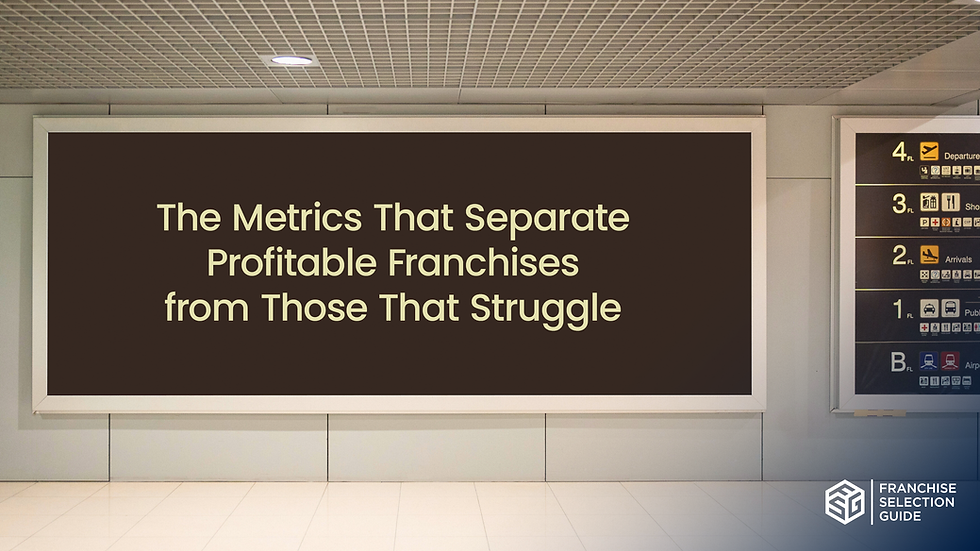KPIs Every Aspiring Franchise Owner Must Understand Before Investing
- Matt Tiefenbrunn

- Apr 27
- 3 min read
Updated: May 31

Investing in a franchise is more than choosing a brand you like. It is a business decision. The difference between those who succeed and those who barely break even comes down to understanding the right numbers from day one.
Most new franchise owners focus on revenue, but revenue alone does not mean profit. A store packed with customers does not guarantee financial health. If you want to make an informed investment, you need to track the right Key Performance Indicators (KPIs).
Here are the essential ones to know before signing a contract.
1. Average Sales: What It Really Tells You
Average sales measure how much revenue a franchise location generates over time. It is often the first number brands highlight, but it does not tell the full story.
What to look for:
Compare sales across multiple locations, not just the highest performers.
Understand seasonality. Sales may spike in certain months but drop in others.
Ask franchisees what their actual take-home pay is after expenses.
How to improve sales:
Use local partnerships to drive more foot traffic.
Train staff to upsell and cross-sell without being pushy.
Price strategically based on market demand.
Reality check: High sales do not guarantee profit. If expenses are too high, even strong revenue will not keep your business afloat.
2. Average Profits: The Real Indicator of Success
Profit is what remains after covering rent, payroll, supplies, franchise fees, and other expenses. This is what determines whether you are running a business or working for free.
What to look for:
Profit margins vary by industry. A franchise with a low margin requires high sales volume to be worth it.
Monthly expenses matter as much as startup costs.
Compare locations in similar markets to set realistic expectations.
How to improve profits:
Keep fixed costs low by negotiating rent before signing a lease.
Track labor costs. Overstaffing drains profits.
Focus on selling high-margin products or services.
3. Break-Even Point: Planning for Profitability
Many franchise owners underestimate how long it takes to become profitable. The break-even point is when revenue covers operating expenses, making it a key milestone.
Key questions to ask:
How long does it take for most franchisees to reach profitability?
What are the biggest expenses in the first year?
How much working capital is needed to sustain the business until profits start coming in?
Ways to reach profitability faster:
Negotiate lease terms with rent discounts for the first few months.
Start lean by hiring only essential staff.
Build brand awareness before opening through pre-launch marketing.
4. Customer Acquisition Cost (CAC) vs. Lifetime Value (LTV)
Franchises come with built-in marketing systems, but not all models create strong customer loyalty. Understanding how much it costs to acquire a customer versus how much revenue they generate over time is key to long-term profitability.
What to analyze:
The average cost of acquiring a customer within the franchise system.
How frequently customers return and their long-term spending habits.
Franchise-driven loyalty programs or retention strategies.
Ways to maximize customer value:
Leverage the franchisor’s marketing while adding local engagement efforts.
Encourage repeat visits through great service and upselling high-value products.
Utilize existing loyalty programs and promotions to strengthen retention.
A strong franchise model should already have a system in place to attract and retain customers. The key is evaluating how effective that system is and optimizing it for your location.
5. Royalty Fees and Hidden Costs
Franchisors charge ongoing fees based on revenue, not profit. This means fees must be paid even if a location struggles. Understanding these costs upfront is essential for managing cash flow.
What to review before signing a contract:
The percentage of revenue allocated to royalty and marketing fees.
Additional costs such as required software, insurance, or vendor agreements.
Insights from existing franchisees on unexpected expenses.
Ways to manage costs effectively:
Speak with multiple franchise owners to get a clear picture of financial obligations.
Negotiate fees where possible or explore options with lower overhead costs.
Build a financial cushion to cover slow months and unexpected expenses.
Making an Informed Investment
Owning a franchise is an exciting opportunity, but it requires a clear understanding of the numbers. The right insights will help you:
Choose a franchise that aligns with your financial goals.
Optimize profitability by managing costs and maximizing revenue.
Build a business that thrives instead of one that struggles to stay afloat.
If you want guidance on evaluating franchise opportunities and financial insights tailored to your goals, let’s talk.




Comments